monsterrack
Silver Member
- Apr 15, 2013
- 4,419
- 5,815
- Detector(s) used
- Garrett, and Whites
- Primary Interest:
- All Treasure Hunting
I wanted to start this to help some folks with what they are finding and it was asked for, but these photo's will only carry you so far. I say read and read and read some more, look at photos of artifacts and pay attention to detail and I mean every detail of an item. Ask someone their opinion on your finds, but if it is not what you want to hear, don't get your feelings hurt. I had a mentor, more than one so I was very blessed. Below I will go over what is chipped/knapped stone and talk about some tools using these photos.
The first 2 photos are of a natural piece of stone that was removed from a larger stone with a few chips that have been broken off by nature.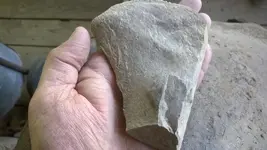
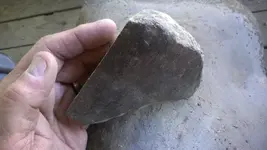 The next photo show what a piece of stone looks like that man has knapped on. Most NA would try out a piece of stone just to see how it flaked or worked and just because you find one like this you can not say it is a hand axe.
The next photo show what a piece of stone looks like that man has knapped on. Most NA would try out a piece of stone just to see how it flaked or worked and just because you find one like this you can not say it is a hand axe.
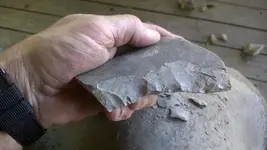
The next few photos are what is called a preform blank.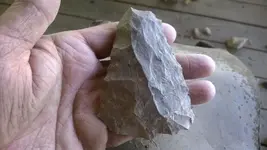
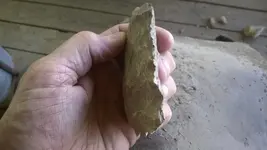
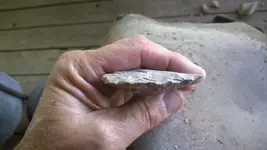 You will notice that the edges are uneven, so this would not make a very good tool unless it was to be used 1 time. Now lets talk on tool types for a moment. In the 3rd photo in this section what you see is the wide end of this blank. You can not say this is a Celt or Adz because with such a jagged edge it would not work very well at all. A Adz has the center of the bit off to one side just like a modern chisel because that's what it was used for, to chop out material. Can you see a modern chisel working well with a broken metal edge. This photo is what a Adz edge would look like.
You will notice that the edges are uneven, so this would not make a very good tool unless it was to be used 1 time. Now lets talk on tool types for a moment. In the 3rd photo in this section what you see is the wide end of this blank. You can not say this is a Celt or Adz because with such a jagged edge it would not work very well at all. A Adz has the center of the bit off to one side just like a modern chisel because that's what it was used for, to chop out material. Can you see a modern chisel working well with a broken metal edge. This photo is what a Adz edge would look like.
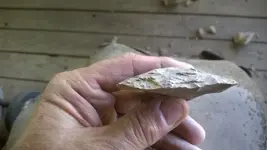 Notice the edge is off to one side of center.
Notice the edge is off to one side of center.
The next photo is what the bit of a chipped Celt would look like. Notice the center of the bit is in the middle of the blade, that way it can do what it was made for and that is chopping. Now to say was it used are not you are getting into another level so lets just stay on( Is this worked stone are not).
Notice the center of the bit is in the middle of the blade, that way it can do what it was made for and that is chopping. Now to say was it used are not you are getting into another level so lets just stay on( Is this worked stone are not).
Flaking types or styles are something you will learn with time and working hard at the study of artifacts. These next photos show just a small example of flaking.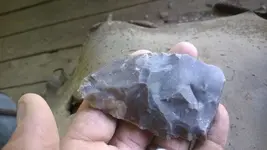 This photo shows what would be called a worked piece of stone. It has been knapped but not really worked on.
This photo shows what would be called a worked piece of stone. It has been knapped but not really worked on.
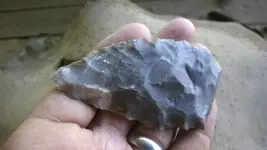 This last photo shows that someone took the time to try and make a tool out of the same stone on the same side has the other photo. You can see this in what is called flake scars , these will not wash away wear off unless it is some type of soft stone. Water will only give it a smooth shine from rolling in a creek. Notice one thing the little white spots that are all over were the flake was removed, that is what is called most of the time finger nail flakes. Sometimes and I say sometimes that is a red flag to some collectors for a reproduction, but we will cross that deep hole another time.
This last photo shows that someone took the time to try and make a tool out of the same stone on the same side has the other photo. You can see this in what is called flake scars , these will not wash away wear off unless it is some type of soft stone. Water will only give it a smooth shine from rolling in a creek. Notice one thing the little white spots that are all over were the flake was removed, that is what is called most of the time finger nail flakes. Sometimes and I say sometimes that is a red flag to some collectors for a reproduction, but we will cross that deep hole another time.
I hope this helps someone and I will be doing other post like this as time lets me another day. This site is not a place just to show our collections and finds, but a place that we can educate beginner and each other. If you have a question PM me and I will try to help, like most of the folks on this site we want to help you in this great hobby not mislead you, puff our self up are to say we know it all.
The first 2 photos are of a natural piece of stone that was removed from a larger stone with a few chips that have been broken off by nature.

 The next photo show what a piece of stone looks like that man has knapped on. Most NA would try out a piece of stone just to see how it flaked or worked and just because you find one like this you can not say it is a hand axe.
The next photo show what a piece of stone looks like that man has knapped on. Most NA would try out a piece of stone just to see how it flaked or worked and just because you find one like this you can not say it is a hand axe.

The next few photos are what is called a preform blank.


 You will notice that the edges are uneven, so this would not make a very good tool unless it was to be used 1 time. Now lets talk on tool types for a moment. In the 3rd photo in this section what you see is the wide end of this blank. You can not say this is a Celt or Adz because with such a jagged edge it would not work very well at all. A Adz has the center of the bit off to one side just like a modern chisel because that's what it was used for, to chop out material. Can you see a modern chisel working well with a broken metal edge. This photo is what a Adz edge would look like.
You will notice that the edges are uneven, so this would not make a very good tool unless it was to be used 1 time. Now lets talk on tool types for a moment. In the 3rd photo in this section what you see is the wide end of this blank. You can not say this is a Celt or Adz because with such a jagged edge it would not work very well at all. A Adz has the center of the bit off to one side just like a modern chisel because that's what it was used for, to chop out material. Can you see a modern chisel working well with a broken metal edge. This photo is what a Adz edge would look like.
 Notice the edge is off to one side of center.
Notice the edge is off to one side of center.The next photo is what the bit of a chipped Celt would look like.
 Notice the center of the bit is in the middle of the blade, that way it can do what it was made for and that is chopping. Now to say was it used are not you are getting into another level so lets just stay on( Is this worked stone are not).
Notice the center of the bit is in the middle of the blade, that way it can do what it was made for and that is chopping. Now to say was it used are not you are getting into another level so lets just stay on( Is this worked stone are not).Flaking types or styles are something you will learn with time and working hard at the study of artifacts. These next photos show just a small example of flaking.
 This photo shows what would be called a worked piece of stone. It has been knapped but not really worked on.
This photo shows what would be called a worked piece of stone. It has been knapped but not really worked on.
 This last photo shows that someone took the time to try and make a tool out of the same stone on the same side has the other photo. You can see this in what is called flake scars , these will not wash away wear off unless it is some type of soft stone. Water will only give it a smooth shine from rolling in a creek. Notice one thing the little white spots that are all over were the flake was removed, that is what is called most of the time finger nail flakes. Sometimes and I say sometimes that is a red flag to some collectors for a reproduction, but we will cross that deep hole another time.
This last photo shows that someone took the time to try and make a tool out of the same stone on the same side has the other photo. You can see this in what is called flake scars , these will not wash away wear off unless it is some type of soft stone. Water will only give it a smooth shine from rolling in a creek. Notice one thing the little white spots that are all over were the flake was removed, that is what is called most of the time finger nail flakes. Sometimes and I say sometimes that is a red flag to some collectors for a reproduction, but we will cross that deep hole another time.I hope this helps someone and I will be doing other post like this as time lets me another day. This site is not a place just to show our collections and finds, but a place that we can educate beginner and each other. If you have a question PM me and I will try to help, like most of the folks on this site we want to help you in this great hobby not mislead you, puff our self up are to say we know it all.
Amazon Forum Fav 👍
Upvote
26





